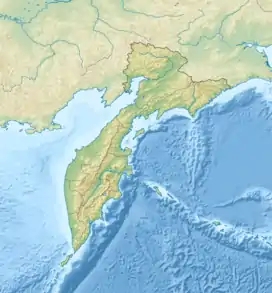1737 Kamchatka earthquake
The 1737 Kamchatka earthquake occurred on October 17 or 16 near the southern tip of present-day Russia's Kamchatka Peninsula.[1] The shock was felt at approximately 03:00 local time or 16:00 UTC by residents on the peninsula and Kuril Islands. The earthquake struck at a shallow depth of roughly 40 km (25 miles) beneath the peninsula. The earthquake had an estimated magnitude of 9.0–9.3 on the moment magnitude scale.
 Epicenter marked as a bullseye. | |
| UTC time | 1737-10-16 16:00:00 |
|---|---|
| Local date | October 17, 1737 |
| Local time | 03:00 |
| Magnitude | 9.0–9.3 Mw 8.3–8.5 Ms |
| Depth | 40 km |
| Epicenter | 52.5°N 159.5°E |
| Type | Megathrust |
| Areas affected | Kamchatka, present-day Russia |
| Tsunami | Yes |
| Casualties | Many natives killed. |
Earthquake
The earthquake was associated with thrust faulting on the subduction zone marked by the Kuril-Kamchatka Trench. Calculation of the earthquake magnitude using tsunami data yielded a moment magnitude of 9.3.[2]
Studies of the earthquake has placed the moment magnitude (Mw ) of this earthquake at 9.0 to 9.3 and 8.3 to 8.5 on the surface wave magnitude.[3][4] The tsunamis generated by this earthquake is thought to be the most destructive and largest ever sourced from the region, alongside the 1952 earthquake. It is thought to be similar in size or possibly larger than the 1952 earthquake.[5]
Descriptions
Stepan Krasheninnikov, a Russian explorer, reported the effects of the earthquake in his 1755 publication Description of Kamchatka Land. According to him, the earthquake lasted 15 minutes and was extremely violent. Many homes, constructed of wood and skin, belonging to the natives were obliterated. Many aftershocks were felt even when the tsunami struck. Aftershocks continued until the spring of 1738.[3][6]
Co-seismic deformation along the coasts was so drastic that natives could not recognize the region or locate their settlements.[3]
Along the Okhotsk Sea coast of Kamchatka, the earthquake and its effects were not noticeable.[3]
Tsunami
On the northern Kuril Islands, the tsunami had an estimated height of 20 meters, and 30 meters in the Avacha Bay. A maximum tsunami amplitude of 12–16 meters was estimated on Amchitka based on evaluating the height where driftwood was found on the island. When Georg Wilhelm Steller, a German scientist and explorer visited the region in 1740, he noted the bones of marine mammals and driftwood discovered well above the shoreline. Trees were also found deposited on a ridge with a height of 230 feet or 70 meters.[7] Krasheninnikov's book mentioned a tsunami measuring three sazhen or 6.3 meters inundating the coast. Another wave measuring 30 sazhen or 63 meters swept through the entire coast, killing many natives and destroying their settlements. The force of the tsunami was so powerful that it stripped away dirt and sand, revealing the basement rocks of the Second Kuril Strait.[3][8]
See also
- Kamchatka earthquakes
- 1841 Kamchatka earthquake – Another Mw 9.0 earthquake in the same region
- List of earthquakes in Russia
- List of tsunamis
- List of historical earthquakes
- List of megathrust earthquakes
References
- "Earthquake Information". Water Damage Defense. Retrieved 2021-06-28.
- Chubarov L.B.; V. K. Gusiakov. "Tsunamis and earthquake mechanism in the island arc region". Science of Tsunami Hazards. 3 (1): 3–21.
- V.K. Gusiakov (2000). "Two great kamchatka tsunamis, 1737 and 1952" (PDF). Institute of Computational Mathematics and Mathematical Geophysics, Siberian Division, Russian Academy of Sciences: IUGG Tsunami Commission. Archived from the original (PDF) on 9 July 2021. Retrieved 8 July 2021.
{{cite journal}}: Cite journal requires|journal=(help) - "Page on tsunami associated with event from West Coast and Alaska warning center". Archived from the original on 2009-05-15. Retrieved 2009-05-20.
- Rhett Butler; David A. Burney; David Walsh (2017). "The orphan Sanriku tsunami of 1586: new evidence from coral dating on Kaua'i" (PDF). Natural Hazards. 88 (2): 797–819. doi:10.1007/s11069-017-2902-7. S2CID 134237666. Retrieved 8 July 2021.
- "Significant Earthquake Information". ngdc.noaa.gov. NCEI. Retrieved 8 July 2021.
- James F. Lander (1996). Tsunamis Affecting Alaska 1737-1996 (PDF). U.S. Department of Commerce, National Oceanic and Atmospheric Administration, National Environmental Satellite, Data, and Information Service, National Geophysical Data Center. p. 195.
- "Tsunami Event Information". ngdc.noaa.gov. NCEI. Retrieved 8 July 2021.